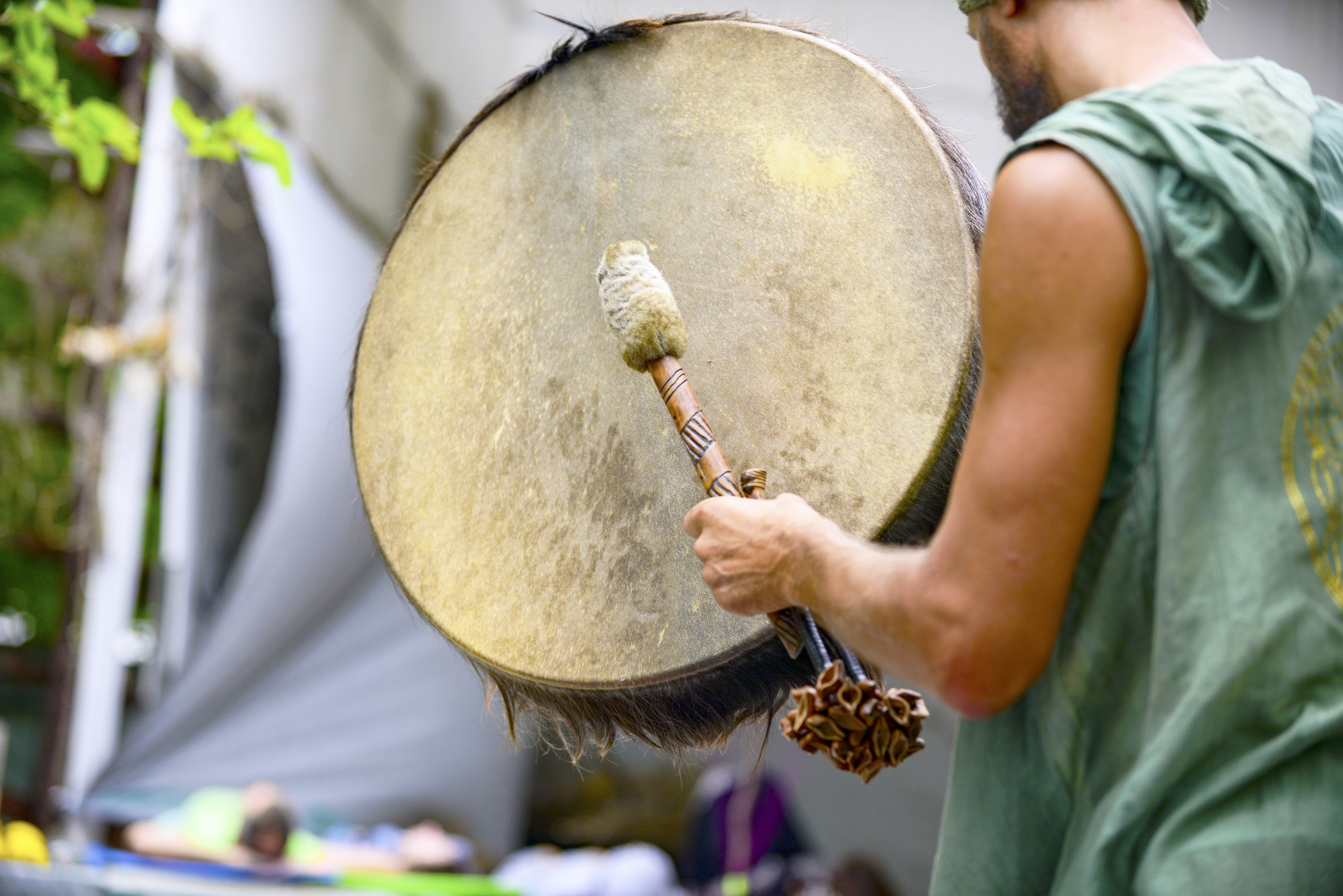Shamanism

What is it?
Shamanism can be so mysterious for many, yet it has been present across cultures for thousands of years. For the average person, the term shaman can invoke the image of a person, usually a man, who has some sort of mystical ability. Shamanism has become increasingly popular in the last several decades, with the term used colloquially in many different contexts.
Shamanism is a spiritual practice that is based on the core belief that everything -and everyone- is interconnected. In fact, some call shamanism “the original spirituality”, as some claim there is evidence of shamanic practice dating back 60,000 years or more. The word shaman comes from the Tungusic word saman, which means “the one who sees”. Looking back, the ancient Greeks attributed sickness to mal’aria (“bad air”) or unseen spiritual forces. Shamanic healers in the Amazon jungle apply the same idea to sickness (“aire malo” in Spanish). Shamans worldwide understand that all illness has an energetic component.
Shamanism is not a religion but a set of beliefs and how practitioners (shamans) practice it is oftentimes adaptable. Nowadays, the word shaman can mean a healer, minister, teacher, astrologer, therapist, among many other things. But at its core, shamans are healers that have the ability to connect to the spiritual realm to create changes that will manifest in the physical world. This sets shamans apart from other practitioners. For example, mediums can use altered states of consciousness but do not take any action in those states. Shamans use this gift for the purpose of healing.
Core philosophy
Shamanism is a deeply spiritual practice, present in different religions and communities. There are core beliefs that are common across shamans around the world. The core beliefs of shamanism are:
- Respect for everything around us. Shamanism recognizes that everything is interrelated and interdependent. That is, if one species suffer, all others are affected.
- The natural world has two aspects. One is the ordinary everyday awareness, which all of us have access to in our daily lives. The other one is non-ordinary awareness, accessed through altered states, or trance.
- Everything is alive and has a spirit. Spirit encompasses all the immaterial forms of life energy that surrounds us. These energies can appear to us in different forms, such as spirits of nature, animals, or ancestors.
- Shamanic practitioners can access other realms of reality. Through altered consciousness, shamans can access non-ordinary reality and view life from a detached, spiritual perspective. One of the most universal methods for altering consciousness is a mesmerizing drumbeat.
- Shamans heal. Shamans act as an intermediary between the non-ordinary reality and the visible world to bring healing to a person.
History
Early origins
Shamanism varies from region to region, country to country as a result of different cultures and beliefs. As shamanism has been around for so long, the exact date of when shamanism actually occurred is a topic of ongoing debate.
Many believe shamanism has been around as early as the Paleolithic era or more commonly known as the Stone age. In Europe and Africa cave artworks from the Paleolithic era dating some 20,000 years ago indicate that shamanic practices were prominent even at that time. Traditional shamanism was a key component of various cultures. In fact, shamans were traditionally chosen by the tribe and were regarded as the societal spiritual counsel.
Aspects of shamanism were encountered in later, organized religions, generally in their mystic and symbolic practices. Greek paganism was influenced by shamanism, as reflected in the stores of Tantalus, Prometheus, Medea, Calypso among others. Some of the shamanic practices of the Greek religion were later adopted into the Roman religion.
There is a strong shamanistic influence in the Bön religion of central Asia, and in Tibetan Buddhism. Forms of shamanistic ritual combined with Tibetan Buddhism became institutionalized as the state religion under the Chinese Yuan dynasty and Qing dynasty. One common element of shamanism and Buddhism is the attainment of spiritual realization, at times mediated by entheogenic (psychedelic) substances.
The spread of Christianity virtually wiped out shamanic practices of many cultures. In Europe, starting around 400 CE, the Christian church was instrumental in the collapse of the Greek and Roman religions. Temples were systematically destroyed and key ceremonies were outlawed. Beginning with the middle ages and continuing into the Renaissance, remnants of European shamanism were wiped out by campaigns against witches. The Catholic Inquisition often orchestrated these campaigns.
Renaissance
The relatively new renaissance of shamanism came in what we know as “neoshamanism”, which is what we see today. Neoshamanism emerged in the 20th century and involves the integration of traditional indigenous shamanic techniques combined with some psychotherapeutic techniques of the urbanized western world. Michael Harner introduced the concept of “core shamanism” in his work “The Way of The Shaman”, which forms the basis of neoshamanism.
With the rise of the movement where people seem to understand consciousness, spiritual connection and healing, shamanism has gained prominence and interest globally. Today shamanism has been studied by researchers and psychologists to better understand how it continuously helps people in their spiritual and mental wellbeing.
Benefits and uses
Although there is little scientific confirmation, ample anecdotal evidence suggests shamanic healing can provide many benefits. Dr. Niva Nagula states that people who have undergone spiritual healing with a shaman have reported the following:
- Healing from emotional trauma
- Changes in negative thoughts and beliefs
- The ability to enter into deep inner states without all the “noise”
- Improved self-confidence
- Better relationships
- Increased energy
- Whole body connectedness
- Feelings of inner peace and happiness
- Improvements in physical ailments
- Lessened depression and anxiety
- Stronger immune system and ability to fight disease
- New motivation to achieve goals
- Clarity around life direction and important decisions
Who practices it
Training
Most shamans trained as an apprentice under an experienced and practicing mentor. They don’t need a degree to follow this path, but they may obtain certificates through organizations. Many shamans choose the apprentice path because they feel it’s a purely spiritual endeavor.
Others choose to develop their path through classes and certificates that are available. Examples are the Last Mask Center for Shamanic Healing, which offers a variety of classes to become a certified shaman. The main location is in Oregon, but there are many locations around the US that offer classes.
Similarly, the Foundation for Shamanic Studies offers an array of workshops that allow participants to gain certificates of completion. The classes can take anywhere from 5 days to 3 years. Even for folks who choose the academic path, they typically need an advisor to guide them along the process.
Aside from finding shamans through these associations, a common way to find shamans is through referrals. Whether is from friends, family or spiritual venues, you can typically find a reputable shaman through referrals, who can give you a sense of what their experience was like.
Things to watch out for
Things to watch out for when looking for a shaman are:
- Anything illegal or unsafe: Examples can be suggesting illegal drugs or consumption of alcohol in prohibited places. A shaman would never suggest anything that would risk your personal safety or freedom.
- Aggressive behavior: A real shaman should never be selling you on their services or aggressive suggesting you need to attend a ceremony or healing of any kind.
- The overnight shaman: As a rule of thumb, go with experienced shamans and avoid practitioners who are still in the apprenticeship process.
- Big promises: Though shamanic sessions can be powerful, there is no guarantee that you will get the healing you think you want. You will only get the healing you can handle and need. If the shaman is making huge promises, there is a chance they are being dishonest.
- No background checks: The shaman should invest time with you beforehand to make sure any ritual or ceremony is the right move for you and be upfront with you if it isn’t your time.
What to expect
Intake
Every shamanic session begins with an intake conversation. Experienced shamans spend most of their time listening. This piece is critical for the shaman to assess your specific situation.
After the conversation is complete, shamans create a sacred space, a symbolic definition of boundaries for you, the shaman and the guiding spirits that will help with the session. The client will lie on their back, wearing loose and comfortable clothing. The shaman will then assess their various energy centers. When the energy work is complete, the shaman conducts a “journey”, where he or she will establish contact with the do a diagnostic journey, where helping spirits will tell us what types of healing or techniques would be most beneficial for the client.
The journey
A shaman can enter the spirit realm via trance, oftentimes induced using rhythmic percussion (a drum or rattle) and/or shaman songs. This is the safest and purest method of reaching these altered states of consciousness. During these trances, the brain enters the Theta brainwave state. The Theta state exists between being awake and asleep. It’s where clairvoyance and deep spiritual connection happens.
Shamans can also use the help of various plant medicines. Plant medicines are highly respected and contain highly psychedelic properties. Some of the more common plants used in shamanic journeys are Ayahuasca, Iboga, San Pedro cactus, psychedelic mushrooms, Salvia and Peyote cactus.
During the shamanic journey, the shaman connects with spirits and travels through 3 different worlds: the lower (nature-based), middle (human reality) and upper (transcendental reality) in search of wisdom and healing for the client. While in this non-physical trance, the shaman may also do either hands-on or hands-off energy work, by channeling energy from the spirit world and moving it through the client’s body accordingly. This portion of the sessions lasts about an hour.
Debrief and integration
Upon completion of the journey, the shaman and the client discuss their experiences. The shaman conveys messages he/she received during the journey and what the client can do to implement teachings in their lives in order to heal. Following a shamanic healing session, many deeply rooted energies shift. So, in the days, weeks, and months following the session, clients should take note of how they feel. It is the shaman’s greatest advice to listen to and accept the energetic changes one may feel following a session. Any discomfort will pass and new, vibrant, life energy will take its place.
In some occasions, a shaman can invite a client to experience their own journey, either via trance or via plant medicines. These plant medicines should be experienced in a ceremonial context with a trained shaman. The shaman’s job during one of these ceremonies is to join the client in his or her journey, hold a safe space, guide, protect, and intervene if needed. The shaman also helps the client to later interpret, understand, and integrate their experience.
Interesting facts
Below are some interesting facts about this fascinating spiritual practice:
- Shamanism is the oldest and most widespread method of healing. Carvings on reindeer bones from the paleolithic period showing the shaman garbed in an animal mask were found in Pin Hole Cave in England.
- The practices of shamans are remarkably similar in Asia, Australia, Africa, The Americas and even in Europe. This is the case despite there being essentially cultural exchanges across the oceans.
- Shamans can be male or female.
- In many cultures, heredity played little part in determining the shaman of the tribe. However, in the northeast part of the Maidu country (in California) all of a shaman’s children had to take up his profession or the spirits would kill them.
- In addition to drums and plants, there are other methods the shaman can use to enter a state of trance. They include fasting for days or weeks, exposing the body to extreme temperatures or going through extraneous physical activities.
- An important part of shamanic ritual was the preparation of the sacred place, dru, costume, special curative clothes, and ritual objects. Wooden images that symbolized incarnations of disease spirtis were used in curative practices.
- Sometimes the shaman sends helper spirits into the body of the sick person to learn the cause of the disease in order to choose the means of healing.
- Rather than waiting for the spirits to visit us, the shaman becomes the visitor into their invisible realms. Because they know the entry points, shamans can cross the borders of ordinary and nonordinary at will.
Closing statement
For many, shamanic healing is an act of Big Love – wider-eyed love that sees the interconnected and interdependent web of life and tries its best to set all things in healthy interdependence, where each layer of reality helps every other layer flourish.
When we are ill in spirit, that illness flows into the other layers: the emotional, the physical, the social, the environmental. We have a very large body, and most of it is unseen and unmeasurable. That body is filled and permeated with an immense gleaming spirit. We have the power to transform self-deprecation, martyrdom, impatience, greed and self-destruction into beauty, love, gratitude and awe. These powers are within us if we will work with them.
Shamans have always understood these things, and it is a great gift that shamans are still operating everywhere. That way, we can get those messages that can help us live a healthier and more fulfilling life.
Newsletter
Sign up for emails to get the scoop on our latest articles, new developments and more.

